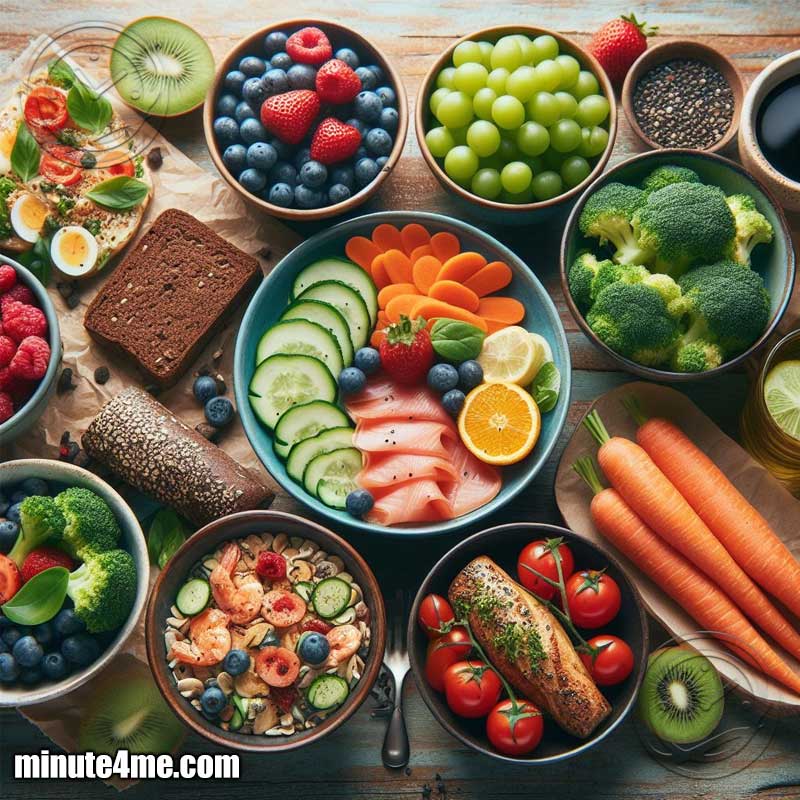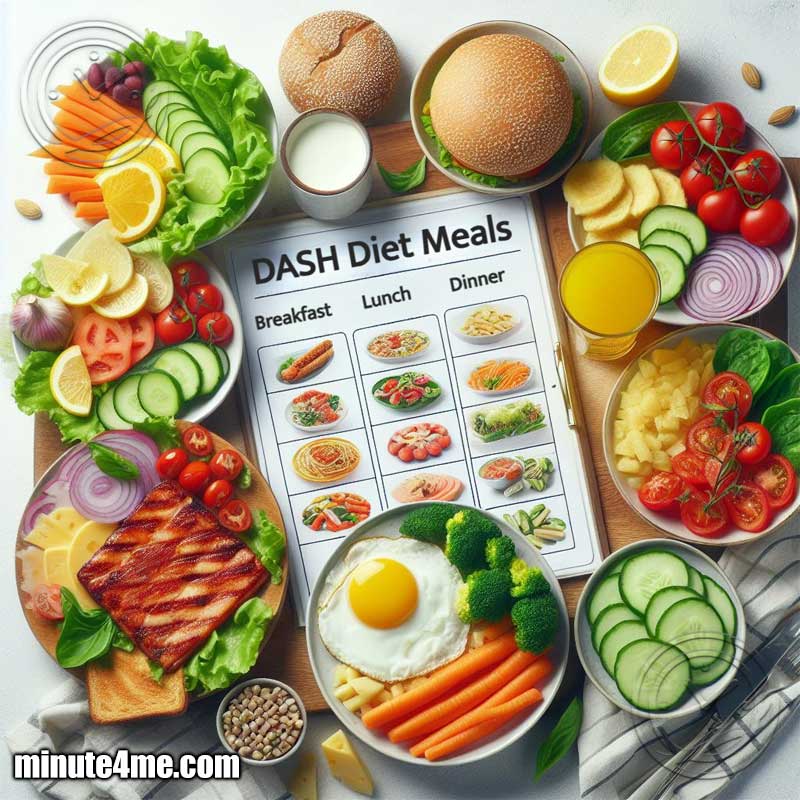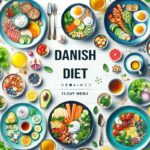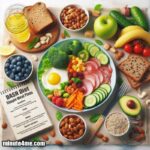Introduction
The DASH diet, standing for Dietary Approaches to Stop Hypertension, is a scientifically backed eating plan aimed at reducing high blood pressure and promoting heart health.
Unlike restrictive diets, the DASH diet focuses on incorporating nutrient-rich foods to provide a balanced intake of fruits, vegetables, whole grains, and lean proteins, all while limiting sodium, added sugars, and unhealthy fats.
This heart-healthy diet not only helps manage blood pressure but also supports overall well-being.
DASH Diet Meals: Your Daily Plan
Creating a daily meal plan that adheres to the DASH diet principles involves focusing on fruits, vegetables, whole grains, and lean proteins, while minimizing your intake of sodium, added sugars, and unhealthy fats.
This balanced approach to eating not only supports blood pressure management but also contributes to overall heart health.
Here’s a detailed breakdown to help you plan your meals effectively:
Scarsdale Diet Meals: Your Ultimate Guide
Unlock the secret to rapid weight loss with Scarsdale Diet Meals, a proven method to shed pounds quickly. Delve into…
Breakfast Options
A heart-healthy breakfast is crucial to start your day off right, providing you with sustained energy and essential nutrients.
Here are some detailed options:
Oatmeal with a Heart-Healthy Twist:
- 1/2 cup of oats cooked with water or low-fat milk
- Topped with a handful of blueberries, sliced almonds, and a dash of cinnamon for added flavor without the sugar
Whole-Wheat Avocado Toast with Egg:
- 1 slice of whole-wheat bread, toasted
- Spread with 1/4 avocado, mashed
- Topped with one poached or boiled egg
- A sprinkle of crushed red pepper flakes for taste
Greek Yogurt Parfait:
- 1 cup of low-fat Greek yogurt
- Layered with mixed berries (strawberries, raspberries, and blackberries)
- A sprinkle of flaxseed or chia seeds for omega-3 fatty acids
- Optional: A small handful of granola for crunch
Key Nutrients:
- Fiber: Found in whole grains, fruits, and seeds, aids digestion and heart health.
- Protein: Essential for building and repairing tissues; choose lean options like eggs and Greek yogurt.
- Healthy Fats: Avocados and nuts provide monounsaturated fats beneficial for heart health.
Lunch Ideas
Lunch on the DASH diet should be a mix of fiber, protein, and healthy fats to keep you full and energized for the rest of the day:
Mixed Greens Salad with Grilled Chicken:
- 2 cups of mixed greens (spinach, arugula, and kale)
- 4 oz grilled chicken breast, sliced
- Topped with sliced cucumber, cherry tomatoes, and a handful of walnuts
- Dressed with olive oil and lemon juice
Lentil Soup and Whole-Wheat Bread:
- 1 serving of homemade or low-sodium canned lentil soup
- Served with a slice of whole-wheat bread for dipping
- Add a side salad for an extra serving of vegetables
Hummus Veggie Wrap:
- 1 whole-wheat tortilla spread with 2 tablespoons of hummus
- Filled with grated carrots, sliced bell peppers, cucumber, and mixed greens
- Rolled and served with a side of quinoa salad for added protein
Key Nutrients:
- Lean Protein: Chicken and lentils are excellent sources that support muscle health and satisfaction levels.
- Complex Carbohydrates: Whole grains and legumes provide sustained energy and fiber.
- Vitamins and Minerals: A variety of vegetables ensures a wide range of essential nutrients for overall health.
Unlock the gateway to vibrant health and tantalizing flavors with the DASH Diet Recipes from Minute 4 Me. Amidst the…
Dinner Recipes
Dinner should be a satisfying meal that supports your dietary goals without adding unnecessary sodium or fats:
Salmon with Roasted Vegetables:
- 4 oz salmon fillet, baked with lemon and dill
- Served with a side of roasted Brussels sprouts and sweet potatoes, seasoned with herbs
Turkey Chili:
- Made with lean ground turkey, kidney beans, tomatoes, and chili spices
- Served with a side of whole-wheat cornbread
Chicken Stir-Fry with Brown Rice:
- Sautéed chicken breast pieces with broccoli, bell peppers, and snap peas
- Served over a cup of cooked brown rice
- Seasoned with low-sodium soy sauce and ginger
Key Nutrients:
- Omega-3 Fatty Acids: Salmon is a rich source, which is beneficial for heart health.
- Fiber: Vegetables and whole grains contribute to a feeling of fullness and aid in digestion.
- Low Sodium: Choosing herbs and spices over salt helps manage blood pressure.
Snacks
Healthy snacking is an integral part of the DASH diet, helping to keep hunger at bay and providing valuable nutrients throughout the day:
- Fruits and Nuts: A small apple or pear with a handful of unsalted almonds
- Vegetable Sticks and Hummus: Carrot, cucumber, and bell pepper sticks with 2 tablespoons of hummus
- Low-Fat Dairy: A cup of low-fat cottage cheese or yogurt, optionally topped with fresh fruit
Key Nutrients:
- Vitamins and Antioxidants: Fresh fruits and vegetables offer a wide range of essential vitamins and antioxidants.
- Calcium and Protein: Low-fat dairy products provide calcium for bone health and protein for muscle maintenance.
- Healthy Fats and Fiber: Nuts are a great source of healthy fats and fiber, contributing to cardiovascular health and satiety.
By incorporating these meal and snack options into your daily plan, you can follow the DASH diet effectively, promoting heart health and managing blood pressure.
Scarsdale Diet Meals: Your Ultimate Guide
Unlock the secret to rapid weight loss with Scarsdale Diet Meals, a proven method to shed pounds quickly. Delve into…
Shopping List
Creating a comprehensive shopping list is a crucial step in successfully adhering to the DASH diet.
This list will guide you through selecting foods that align with the diet’s principles, focusing on low sodium, high fiber, and nutrient-dense options.
Here’s a detailed shopping list to get you started:
Fruits and Vegetables:
- Fresh produce: Aim for a rainbow of colors (e.g., kale, spinach, carrots, berries, apples) to maximize nutrient intake.
- Frozen vegetables: Great for convenience, choose those without added sauces or salt.
- Canned fruits: Look for options in water or their own juice, not syrup.
Whole Grains:
- Brown rice, whole wheat pasta, and quinoa: Excellent sources of fiber and nutrients.
- Whole grain bread: Check labels to ensure it’s made with 100% whole grains.
- Oats: Old-fashioned or steel-cut are preferable for their minimal processing.
Proteins:
- Lean meats: Such as chicken breast and turkey.
- Fish: Especially fatty fish like salmon and mackerel, rich in omega-3 fatty acids.
- Plant-based proteins: Beans, lentils, chickpeas, and tofu are great options.
Dairy:
- Low-fat or fat-free milk, yogurt, and cheese: To reduce saturated fat intake.
Fats and Oils:
- Healthy fats: Olive oil, avocado, and nuts.
- Seeds: Flaxseeds, chia seeds, and pumpkin seeds for added nutrients and fiber.
Miscellaneous:
- Herbs and spices: To flavor dishes without adding sodium.
- Low-sodium broths: For cooking grains or as a base for soups.
- Vinegars: Such as apple cider or balsamic for salads and cooking.
Key Shopping Tips:
- Read labels carefully: Look for low-sodium, no added sugars, and whole grain options.
- Prioritize fresh produce: But remember frozen and canned can be just as nutritious.
- Variety is key: Ensure a wide range of fruits, vegetables, and protein sources to cover all essential nutrients.
Tips for Adapting Meals to the DASH Diet
Adapting your favorite meals to fit the DASH diet guidelines can be simple with a few adjustments.
Here are some strategies to help you modify recipes and meal plans:
- Reduce Sodium: Replace table salt with herbs, spices, lemon juice, or vinegar to enhance flavors without increasing blood pressure.
- Choose Whole Grains: Substitute white bread, pasta, and rice with their whole grain counterparts for added fiber and nutrients.
- Opt for Lean Proteins: Replace fatty cuts of meat with leaner options like poultry without the skin, fish, or plant-based proteins.
- Increase Vegetables and Fruits: Add extra servings of vegetables to meals, and use fruits as the basis for desserts.
- Select Low-Fat Dairy Products: Use low-fat or fat-free milk, yogurt, and cheese in recipes.

Recipe Adjustments:
- Boost flavor without salt: Use a mix of herbs and spices like garlic powder, paprika, and oregano.
- Modify cooking methods: Favor baking, grilling, steaming, or sautéing over frying.
- Be mindful of portion sizes: Especially for high-calorie foods, even if they fit within DASH guidelines.
DASH Diet Macronutrients
The DASH diet emphasizes a balanced intake of macronutrients to support heart health and lower blood pressure.
Understanding the role of proteins, carbohydrates, and fats within this dietary plan is crucial for planning meals effectively:
- Proteins: Essential for repairing and building tissues. Lean sources like poultry, fish, and beans are recommended to reduce saturated fat intake.
- Carbohydrates: Should come primarily from whole grains, fruits, and vegetables to ensure a high intake of fiber and essential nutrients.
- Fats: Focus on healthy fats found in fish, nuts, and olive oil, which can help improve heart health by reducing bad cholesterol levels.
| Macronutrient | Recommended Sources |
|---|---|
| Protein | Chicken, fish, beans, lentils, tofu |
| Carbohydrates | Whole grains, fruits, vegetables |
| Fats | Olive oil, nuts, seeds, avocado |
Balanced Nutrition:
- Monitor protein sources: Opt for lean and plant-based options.
- Choose complex carbohydrates: For longer-lasting energy and satiety.
- Incorporate healthy fats: Essential for nutrient absorption and heart health.
Challenges and Solutions
Adopting the DASH diet can come with its set of challenges, but there are practical solutions to overcome them:
Reducing Sodium Intake:
- Challenge: Many find it difficult to cut back on salt due to habitual taste preferences or reliance on processed foods.
- Solution: Gradually decrease salt in recipes to adjust your palate and explore other seasonings like herbs and spices.
Eating Enough Fruits and Vegetables:
- Challenge: Incorporating the recommended servings of fruits and vegetables into every meal can be daunting.
- Solution: Add vegetables to every meal, snack on fruits, and choose vegetable-based soups and stews.
Meal Planning and Preparation:
- Challenge: Busy schedules can make it hard to plan and prepare DASH-friendly meals.
- Solution: Dedicate time each week to meal planning and batch cooking. Use frozen or canned produce to save time without sacrificing nutritional value.
Overcoming Obstacles:
- Start small: Make gradual changes rather than overhauling your diet overnight.
- Seek support: Connect with others following the DASH diet or consult a dietitian.
- Be patient: Adjusting to a new eating pattern takes time, and benefits will accumulate with consistency.
Conclusion
Adopting the DASH diet is about more than just lowering blood pressure; it’s a commitment to a healthier lifestyle.
By focusing on nutrient-rich foods and making informed choices about what you eat, you can support your heart health and overall well-being.
Remember, it’s always advisable to consult with a healthcare provider before starting any new diet, especially if you have existing health conditions.
Embrace the journey towards a healthier heart with the DASH diet.






